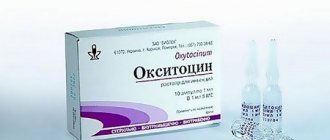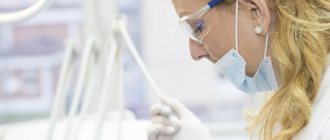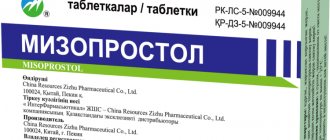Drugs for contraction of the uterus in order to prevent the development of dangerous consequences after curettage (abortion) are prescribed in case of insufficiently active contraction of the organ. This situation is dangerous due to bleeding and the fact that blood clots may remain in the uterine cavity after curettage. In the future, this becomes the cause of serious inflammation.
In order to contract the uterus after curettage, a woman may be prescribed the following medications:
Oxytocin
When hearing the word Oxytocin, many women immediately remember childbirth. It is this artificial hormone that is used to stimulate uterine contractions and enhance labor. But Oxytocin is one of the drugs that is prescribed to women after uterine curettage.
Oxytocin has the following properties.
- Tones the smooth muscles of the uterus, causing it to contract and return to its previous size. If its contractility is impaired, then blood clots remaining in the cavity can cause inflammation.
- Promotes spasm of the spiral arteries of the uterus, stopping postoperative bleeding.
- Oxytocin acts on the female body as an antidepressant. Relieves anxiety that inevitably arises after curettage as a result of hormonal changes.
Oxytocin after curettage allows you to avoid complications caused by uterine bleeding, stretching of an organ or ligamentous apparatus.
Insufficiently active contraction of the uterus after curettage can further negatively affect the health of the female reproductive system. But administering a drug to stimulate the organ makes sense only during the first few days. This is explained by the fact that the non-pregnant uterus does not respond properly to Oxytocin. And even significant dosages of the drug give minimal effect.
After entering the blood, Oxytocin stimulates the smooth muscles of the uterus, causing its active contraction. In order to adjust the strength and frequency of contraction, minimal doses of the drug are used. But the more time passes after curettage, the less pronounced the effect of oxytocin is.
Side effects of the drug are:
- Development of swelling. Oxytocin can cause fluid retention, which is accompanied by swelling and infrequent urination.
- Bradycardia (decrease in heart rate).
- Anaphylactic shock. The condition develops as a result of an allergic reaction to a synthetic analogue of oxytocin.
- Nausea ending in vomiting. Occurs after administration of a high dose of the drug.
If the side effects are too severe, then uterine contraction after curettage will be stimulated by other drugs.
The product is used only in a hospital setting and under medical supervision.
How does oxytocin work after an abortion?
Oxytocin is a peptide hormone synthesized by the brain, namely its hypothalamic-pituitary region. It affects the sexual functions of the body: enhances uterine contractions, increases the tone of the myometrium, promotes dilation of the cervix, and reduces blood pressure. In a woman’s body, this hormone increases during sexual arousal, before childbirth and during breastfeeding. The origin of the mother’s attachment to the baby depends on it.
Due to the specific effects on the female body, oxytocin is actively used during abortion. Immediately after sexual intercourse, the drug prevents the attachment of a fertilized egg to the walls of the uterus due to the fact that oxytocin increases the tone of the myometrium. The fertilized egg will not be able to gain a foothold, so it will soon come out along with a small amount of blood. This effect underlies the use of oxytocin as an abortifacient in the early stages of pregnancy - 1-2 weeks after conception.
Oxytocin is most often used after abortions performed later in pregnancy as a preventive measure for uterine bleeding. Their cause is either endometritis (inflammation of the uterine mucosa damaged by the fertilized egg breaking away from it), or an inflammatory process caused by infection. Oxytocin injections are often prescribed to women who have undergone a medical abortion or miscarriage due to incomplete release of parts of the embryo.
Analgin-quinine
Analgin-quinine is widely used in gynecological practice. The drug has good analgesic properties, but the drug is also used to contract the uterus after curettage. Its use for this purpose is justified if the organ returns too slowly to normal size.
After curettage of the uterus, Analgin-quinine can be prescribed in combination with Oxytocin. The latter is administered intramuscularly and shortens the recovery period of uterine tissue after curettage.
To improve the contractility of the uterus after curettage, the drug is prescribed three times a day. The product should be taken either 1 hour before meals or 2 hours after meals. The duration of drug therapy is individual, but in most cases it is 7–10 days.
Treatment with this drug for the purpose of contracting the uterus after curettage is carried out only under medical supervision. Self-administration of medication can lead to irreversible consequences.
The drug has its contraindications that must be taken into account. The medicine is prohibited for use in the following cases:
- the presence of problems with the functioning of the kidneys or liver;
- if the woman has diagnosed asthma;
- for severe forms of myasthenia;
- with optic neuritis;
- in the presence of pathologies that cause spasm of the bronchi;
- with hemolytic anemia;
- in case of significant hearing loss or existing ear infection;
- in case of hematopoietic dysfunction.
While taking the medication, there is a high probability of developing side effects. These include:
- nausea;
- diarrhea;
- vomit;
- internal bleeding and ulceration of the gastric mucosa (rare);
- dizziness, increased fatigue, hand tremors, sleep disturbances;
- increased heart rate, angina attacks;
- tinnitus, hearing impairment and color perception, narrowing of the visual field;
- leukopenia;
- disturbances in the functioning of the renal system, electrolyte retention.
Sometimes, during treatment with this drug, various allergic reactions occur. It could be:
- urticaria, skin itching, eczema;
- bronchospasm;
- anaphylactic shock (in rare cases);
- increase in body temperature (most often).
Analgin-quinine overdose is quite common. Its signs are:
- nausea ending in vomiting - in some cases, the contents of the stomach contain blood;
- dizziness accompanied by tinnitus;
- convulsions;
- skin rashes;
- development of aplastic type of anemia;
- complex blood disorders;
- black stool with a tarry consistency;
- the formation of anaphylactic shock, in rare cases ending in coma.
There are no specific antidotes. The woman is prescribed gastric lavage and hepatoprotectors.
Ginestril
Ginestril is a medication designed to improve uterine contractions by blocking the production of the hormone progesterone.
There are many contraindications to taking Ginestril, as with other hormonal drugs. In particular, it will be prohibited for use in cases of severe anemia, as well as inflammation of the reproductive system.
Tablets are prescribed with caution for pulmonary pathologies, asthma and heart rhythm disorders.
Women tolerate the medicine quite well. In rare cases, symptoms of urticaria develop. Nausea and a feeling of general malaise may develop.
Dinoprost
Dinoprost is one of the medications widely used in obstetric practice after curettage of the uterus in order to improve its contractility. Dinoprost is used only in a hospital setting, since the woman needs careful medical supervision.
The drug is prohibited for use by women with heart and vascular problems, as well as bronchial asthma, severe hypertension, glaucoma, liver and kidney diseases. An absolute contraindication to the use of Dinoprost is the presence of a uterine scar.
The attending physician should select and prescribe drugs to contract the uterus after curettage. Self-appointment is unacceptable.
Hematometer? How I avoided curettage using oxytocin.
The uterus is a very interesting female organ. On the one hand, it makes us the happiest - it gives us children, but on the other hand, it brings health problems to a woman, and severe uterine bleeding can sometimes take a life in a short time.
Let me start with the fact that I have never suffered from a single female disease, not a single cycle disorder, or pain in those very days. And two pregnancies proceeded with a bang.
After the first emergency caesarean section (large fetus), exactly 40 days later, as expected, I went for an examination to the gynecologist who managed my pregnancy. An examination of the chair revealed nothing. We moved on to the ultrasound machine and then I heard the strange word “hematometra”. What is this, who is this - I don’t understand! The doctor explained that the uterus was filled with blood, and that not all came out after childbirth. She prescribed me to inject one ampoule of oxytocin per day for 3 days. If it doesn’t help, then she will do a probing of the cervix herself and the accumulation will come out. I also took a smear test. Three days later I came to the appointment, there was no discharge, they did an ultrasound again - the hematometer remained! And the leukocytes seemed to be a little high, and therefore the doctor did not do any probing, but wrote me a referral to the hospital for curettage. I was shocked, especially since I knew that such manipulations or abortion were undesirable after a caesarean section.
I arrived at the hospital and was told to wait for the doctor, as he was undergoing surgery. How long to wait - Unknown. The head of the department didn’t want to see me and told the nurse to admit me to the hospital without an examination. But wait, how is this so? If you do not want to register without an examination, take a receipt from me refusing hospitalization. I didn’t write anything and sat for another hour waiting. Then I mentally sent everything to hell and went from the city to the regional hospital. There is no difference according to the policy. But the doctor was no longer there. An experienced adult Nurse looked at my referral and noted that I walk very quickly and look good for a woman with such a diagnosis. She said that if there is no pain, then you will live normally until tomorrow and will come to the doctor in the morning. Which is what I did this morning. The doctor, having examined me in a chair, said that there was no enlargement of the uterus, and I did not experience pain at all. Hospitalization and cleaning are not necessary. But just in case, I asked to redo the ultrasound. This time, an incredibly experienced doctor gave me an ultrasound, thanks to whom I was also born. He said that there was some fluid in the uterus, most likely a small piece of lochia residue was blocking the exit of the fluid. He prescribed me the same oxytocin, only 3 times a day, plus 3 times a Noshpa tablet. And what do you think, the uterus contracted, these three drops of liquid came out and that’s it, no more hematometer appeared on the ultrasound!
Oxytocin after curettage
July 25, 01:21
Feelings in the abdomen after curettage (SB)
Girls, hello everyone! More than a month has passed since this terrible operation.. curettage.. I was in the hospital for three days.. they put AB, oxytocin and papaverine there.. After discharge, I took AB and fluconazole.. and that’s all.. After the operation it bled a little..
They did an ultrasound 2 times the next morning after the operation and a couple more days later.. Everything was cleaned well, the uterus shrank.. For a month it was periodically smeared with dark (the doctor warned that this could happen and this is normal)... then after 27 days (like once my cycle) started M..
the first three days were… Read more →
Hematometer?
So today I went for an ultrasound to check how the curettage was done after ST. The ultrasound specialist, unfortunately, did not make me happy ((. In conclusion, she wrote: “Hematometra? Remnants of the fertilized egg? Ultrasound signs of adhesions.” Read more →
Recovery after an emergency
On 10.02 I found out that my pregnancy froze at 7 weeks, on 11.02 I had a curettage, on 12.02 I was allowed to go home from the hospital, on 13.02 I accidentally found a gynecologist, I hope, a good and caring one. And this is what I want to tell you about... Continue reading →
Continuation of my misadventures
The beginning of my story is in the previous post. In short: the third birth went quickly and wonderfully; before discharge, they performed a curettage and sent me home the next day. For my own peace of mind, I went for an ultrasound 5 days later, and there were clots in the uterus again.
They prescribed injections of oxytocin and no-shpu. I went to the gynecology hospital for injections twice a day. On the third day, in the evening, my temperature rose to 38.5. The next day I reported this to the gynecologist, he looked at the ultrasound and said that there was nothing from the uterus...
Continue reading →
M after cleaning. When did it start for whom?
Girls, hello everyone.
On May 18, there was a miscarriage at 12 weeks B, with curettage, with very large blood loss. There was discharge for 12 days, sometimes it was there, sometimes it wasn’t. We looked at the ultrasound hematrometer. Continue under the cut Read more →
Consequences of curettage after ST
Girls, I recently asked for your advice regarding the enlarged uterine cavity. There were no answers from you - apparently no one, thank God, had any experience with this. I decided to unsubscribe for those who, like me, would be looking for information. Yesterday everything fell into place (after almost 6 months). I came to Re for the next cycle - the cavity was expanded again (accordingly, cryo was postponed)... Read more →
My birth 07/10/13 (29 maternity hospital)
For myself, for you and for descendants =) I’ll start with the fact that when planning a baby, a month before pregnancy, in September, I was diagnosed (in a paid clinic, seen by two doctors!) with ovarian dysfunction and infertility))) But here It’s the beginning of November and I, with hellish pain in the lower abdomen and a two-day delay, go to a medical facility, where they tell me “the fertilized sac is approx. 2.5 weeks”! I do a test at home - yes, I’m pregnant! The pregnancy was not quite easy - toxicosis, headaches, once during pregnancy, severe tracheitis... Continue reading →
ultrasound after cleaning
Is it necessary to do an ultrasound after curettage? We did it yesterday. I feel good, I’m taking metronidazole, oxytocin, cefazolin, and taking ascorutin. I asked the doctor if I should do an ultrasound, she said no.
I think I read that they usually do it after 5 days. Should I pay for it for my peace of mind or is it better not to climb again? They brought the girl into the ward - they cleaned her poorly, and cleaned her a second time. I'm afraid that this won't happen to me either...
Continue reading →
my zb (medabort 11.18, and the result of the hyster)
Good afternoon girls! I decided to write this post for those who, unfortunately, may encounter such a situation. 01/09/09 I had a hysteroresectoscopy + curettage and, as the gynecologist said, it’s good that they did it! Multiple adhesions due to the inflammatory process after an abortion! Remnants of the fertilized egg! and the whole uterus is soft.
Shock of course. I survived the hysteria much easier than the medical abortion. What kind of doctors do we have anyway... I went for 2 months with the remains (((So if there is such a situation... sb... then you need to take medication before the term for a maximum of 5 weeks, and then just cleaning!!!! But this is purely my opinion, after everything I’ve experienced….
Continue reading →
Periods after childbirth
Good afternoon, girls! This is probably a million-dollar topic, but still... How was your first period after giving birth? Before pregnancy, menstruation always came on time and was 5 (2.3 days the heaviest bleeding) after 28. Read more →
Not much late
Hello girls. I really want to join you, I didn’t have time to get pregnant, so at least get into the development of the child. ))) I’ve really been with you for a long time and haven’t missed a single week, read your messages and empathized. We were born at exactly 40 weeks, on February 23rd.
I’m home now, although I have complications after childbirth. The uterus contracts poorly. In the maternity hospital, curettage was repeated. And now I’ve already managed to visit my gynecologist, the result: a course of antibiotics and oxytocin. It's still complicated by the fact that I'm alone...
Continue reading →
Pregnancy after a miscarriage - a lot of questions for those who have experienced ((
Dear BBshechki, such a misfortune befell me as a frozen pregnancy ((And now I seem to have moved away from all this and I have a whole bunch of questions…..
Read more →
our path…..
Source: https://www.BabyBlog.ru/theme/oksitocin-posle-vyskablivaniya
Oxytocin
When hearing the word Oxytocin, many women immediately remember childbirth. It is this artificial hormone that is used to stimulate uterine contractions and enhance labor. But Oxytocin is one of the drugs that is prescribed to women after uterine curettage.
Oxytocin has the following properties.
- Tones the smooth muscles of the uterus, causing it to contract and return to its previous size. If its contractility is impaired, then blood clots remaining in the cavity can cause inflammation.
- Promotes spasm of the spiral arteries of the uterus, stopping postoperative bleeding.
- Oxytocin acts on the female body as an antidepressant. Relieves anxiety that inevitably arises after curettage as a result of hormonal changes.
Oxytocin after curettage allows you to avoid complications caused by uterine bleeding, stretching of an organ or ligamentous apparatus.
Insufficiently active contraction of the uterus after curettage can further negatively affect the health of the female reproductive system. But administering a drug to stimulate the organ makes sense only during the first few days. This is explained by the fact that the non-pregnant uterus does not respond properly to Oxytocin. And even significant dosages of the drug give minimal effect.
After entering the blood, Oxytocin stimulates the smooth muscles of the uterus, causing its active contraction. In order to adjust the strength and frequency of contraction, minimal doses of the drug are used. But the more time passes after curettage, the less pronounced the effect of oxytocin is.
But too large doses of the drug can lead to contraction of the uterus to a state of tonic contractures.
Side effects of the drug are:
- Development of swelling. Oxytocin can cause fluid retention, which is accompanied by swelling and infrequent urination.
- Bradycardia (decrease in heart rate).
- Anaphylactic shock. The condition develops as a result of an allergic reaction to a synthetic analogue of oxytocin.
- Nausea ending in vomiting. Occurs after administration of a high dose of the drug.
If the side effects are too severe, then uterine contraction after curettage will be stimulated by other drugs.
The product is used only in a hospital setting and under medical supervision.
conclusions
In the abortion and contraception department of the Diana Medical Center, the use of oxytocin after an abortion is carried out only if there are appropriate indications and under the supervision of qualified specialists.
Modern diagnostic equipment and extensive experience allow the clinic’s gynecologists to accurately determine the presence of inflammatory processes or incomplete removal of the fertilized egg from the uterus, which is eliminated by introducing oxytocin into the woman’s body.











